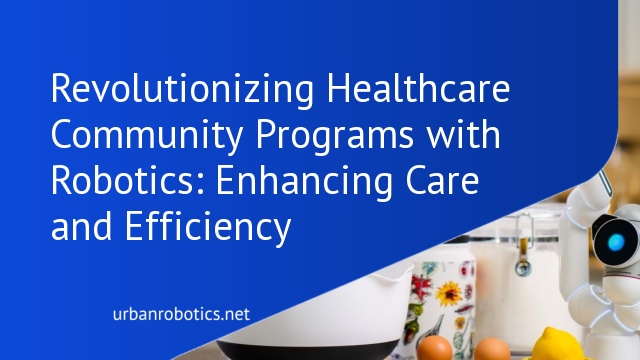Overview of Healthcare Community Programs
Healthcare community programs focus on delivering health services, education, and support directly to community members. These programs often target various demographics, including the elderly, children, and underserved populations. Through initiatives like health fairs, mobile clinics, and educational workshops, these programs aim to improve overall public health by making services more accessible.
Robotics plays a crucial role in these community programs by enhancing service delivery. Automated medication dispensers, for instance, ensure that patients adhere to their treatment schedules, reducing hospital admissions. Robotic companions provide emotional support to elderly individuals, helping them combat loneliness and mental health issues.
Programs also incorporate robotic-assisted rehabilitation for stroke patients, enabling them to recover faster and more effectively. Mobile health units equipped with diagnostic robots offer medical services in remote areas, bridging the gap in healthcare accessibility. By including robotics in these community programs, we’re not just improving efficiency but also elevating the quality of care provided to diverse populations.
The Role of Robotics in Healthcare
Robotics is revolutionizing healthcare by integrating advanced technology to improve patient outcomes, enhance efficiency, and expand accessibility. These innovations are pivotal in various community programs.
Types of Robotics Used
Robotics in healthcare includes surgical robots, which perform precise operations, and rehabilitation robots that aid recovery for stroke patients. We also see robotic medication dispensers ensuring timely drug administration, and telepresence robots enabling remote consultations. Diagnostic robots perform early detection of conditions, particularly in underserved regions.
Benefits of Robotics in Healthcare
Robotics enhances healthcare by increasing precision in surgeries, leading to quicker recovery and fewer complications. It improves accessibility with telepresence robots, making medical consultations available remotely. Medication dispensers ensure compliance, reducing errors. Diagnostic robots offer early condition detection, improving treatment outcomes and reducing healthcare costs.
Successful Programs Implementing Robotics
Many healthcare community programs showcase the effective use of robotics to enhance patient care and operational efficiency.
Case Study 1: Senior Care Facilities
Senior care facilities have adopted robotic companions to support elderly residents. PARO, a therapeutic robotic seal, reduces stress and improves emotional well-being. These robots, equipped with sensors, respond to touch and voice, offering a comforting presence. Medication robots, like Mabu, remind patients to take their medication on time, ensuring adherence to prescribed treatments. Programs integrating these robots show higher patient satisfaction and reduced healthcare costs.
Case Study 2: Remote Patient Monitoring
Remote patient monitoring programs utilize telepresence robots to bridge the gap between patients and healthcare providers. For example, InTouch Health’s robots facilitate real-time consultations, offering immediate medical assistance. These robots monitor vital signs, collect health data, and provide alerts for any abnormalities. Patients in rural areas or with mobility issues can access quality care without traveling long distances. Such programs help in early detection of health issues, improving outcomes and reducing unnecessary hospital visits.
Challenges and Limitations
Healthcare community programs with robotics face several challenges and limitations that must be addressed to ensure successful integration and widespread adoption.
Cost and Accessibility
Robotics in healthcare often requires significant financial investment. The purchase, maintenance, and upgrading of robotic systems can be expensive, creating barriers for smaller healthcare facilities and lower-income communities. For instance, surgical robots such as the da Vinci system can cost millions of dollars, limiting their accessibility. Additionally, specialized training for medical staff is needed, further increasing costs and limiting the number of facilities that can effectively use these advanced tools.
Ethical Considerations
Robotic integration in healthcare raises ethical questions regarding patient care and data privacy. Ensuring that robots respect patient autonomy and confidentiality is crucial. There’s also the concern of job displacement for healthcare workers as robots take over certain tasks, leading to potential job losses. Privacy concerns arise with telepresence and monitoring robots as they collect and transmit patient data, necessitating robust cybersecurity measures to protect sensitive information. Ensuring ethical usage while maintaining patient trust remains a significant challenge.
Future Trends in Robotics for Healthcare
Robotic advancements will revolutionize healthcare. Artificial intelligence (AI) enables robots to perform complex tasks with high precision. AI-driven robots can analyze vast medical data, providing insights for personalized medicine and predictive diagnostics.
Wearable robots assist patients in rehabilitation. Companies are integrating robotics into exoskeletons to support mobility and enable intensive physical therapy at home. These devices reduce hospital visits and aid faster recovery.
Nanorobots promise targeted drug delivery. Researchers are developing tiny robots to transport medication directly to diseased cells, minimizing side effects and increasing treatment efficacy. This innovation holds potential for cancer therapy and chronic disease management.
Collaboration between robots and humans offers enhanced patient care. Surgical robots assist surgeons in precise procedures, reducing complications and recovery times. We expect increased adoption as technology improves and costs decrease.
Telehealth robots increase accessibility to remote areas. These robots provide virtual consultations, bridging the gap in healthcare access for underserved communities. Remote monitoring by these robots ensures continuous care, enabling early intervention and better health outcomes.
Robotic companions support mental health. These robots offer companionship and cognitive stimulation for the elderly and patients with mental health conditions, improving their quality of life. Developments in this area enhance emotional well-being and reduce feelings of isolation.
We foresee these trends reshaping healthcare, making treatments more precise, accessible, and personalized. The integration of these robotic innovations in community programs ensures a future where healthcare is efficient and effective for all.
Conclusion
Healthcare community programs are experiencing a transformative shift with the integration of robotics. These advancements are not just enhancing patient care but also making healthcare more efficient and accessible. From surgical robots to telehealth consultations and mental health support, the potential of robotics in healthcare is vast and promising. As we continue to innovate, the collaboration between humans and robots will play a crucial role in delivering personalized and precise healthcare solutions. The future of healthcare is bright, and with robotics at the forefront, we’re on the path to a more advanced and compassionate healthcare system.





